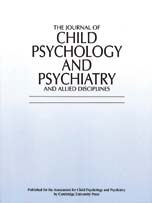Crossref Citations
This article has been cited by the following publications. This list is generated based on data provided by
Crossref.
MOTA, VICTOR LEWIS
and
SCHACHAR, RUSSELL J.
2000.
Reformulating Attention-Deficit/Hyperactivity Disorder According to Signal Detection Theory.
Journal of the American Academy of Child & Adolescent Psychiatry,
Vol. 39,
Issue. 9,
p.
1144.
van Prooijen, Jan-Willem
and
van der Kloot, Willem A.
2001.
Confirmatory Analysis of Exploratively Obtained Factor Structures.
Educational and Psychological Measurement,
Vol. 61,
Issue. 5,
p.
777.
Kooistra, L
Stemerdink, N
van der Meere, J
Vulsma, T
and
Kalverboer, AF
2001.
Behavioural correlates of early‐treated congenital hypothyroidism.
Acta Paediatrica,
Vol. 90,
Issue. 10,
p.
1141.
Huss, M.
Iseler, A.
and
Lehmkuhl, U.
2001.
Interkultureller Vergleich der Conners-Skalen: Lässt sich die US-amerikanische Faktorenstruktur an einer deutschen Klinikstichprobe replizieren?.
Zeitschrift für Kinder- und Jugendpsychiatrie und Psychotherapie,
Vol. 29,
Issue. 1,
p.
16.
Os, Jim van
Wichers, Marieke
Danckaerts, Marina
Van Gestel, Sofie
Derom, Catherine
and
Vlietinck, Robert
2001.
A prospective twin study of birth weight discordance and child problem behavior.
Biological Psychiatry,
Vol. 50,
Issue. 8,
p.
593.
Oostrom, K.J.
Schouten, A.
Kruitwagen, C.L.J.J.
Peters, A.C.B.
and
Jennekens‐Schinkel, A.
2001.
Epilepsy‐related ambiguity in rating the child behavior checklist and the teacher's report form.
Epileptic Disorders,
Vol. 3,
Issue. 1,
p.
39.
ROHDE, LUIS A.
BARBOSA, GENÁRIO
POLANCZYK, GUILHERME
EIZIRIK, MARIANA
RASMUSSEN, ERIK R.
NEUMAN, ROSALIND J.
and
TODD, RICHARD D.
2001.
Factor and Latent Class Analysis of DSM-IV ADHD Symptoms in a School Sample of Brazilian Adolescents.
Journal of the American Academy of Child & Adolescent Psychiatry,
Vol. 40,
Issue. 6,
p.
711.
Glisson, Charles
Hemmelgarn, Anthony L.
and
Post, James A.
2002.
The Shortform Assessment for Children: An Assessment and Outcome Measure for Child Welfare and Juvenile Justice.
Research on Social Work Practice,
Vol. 12,
Issue. 1,
p.
82.
Escher, Sandra
Romme, Marius
Buiks, Alex
DELESPAUL, PHILIPPE
and
Van Os, Jim
2002.
Independent course of childhood auditory hallucinations: A sequential 3-year follow-up study.
British Journal of Psychiatry,
Vol. 181,
Issue. S43,
p.
s10.
Jacobs, N
Rijsdijk, F
Derom, C
Danckaerts, M
Thiery, E
Derom, R
Vlietinck, R
and
van Os, J
2002.
Child psychopathology and lower cognitive ability: a general population twin study of the causes of association.
Molecular Psychiatry,
Vol. 7,
Issue. 4,
p.
368.
Treffers, Flip D. A.
2002.
De diagnostische validiteit van angststoornissen bij kinderen en adolescenten.
Kind en adolescent,
Vol. 23,
Issue. 4,
p.
137.
Oostrom, Kim J.
Schouten, Anneke
Kruitwagen, Cas L. J. J.
Peters, A. C. B.
and
Jennekens‐Schinkel, Aagje
2003.
Behavioral Problems in Children with Newly Diagnosed Idiopathic or Cryptogenic Epilepsy Attending Normal Schools Are in Majority Not Persistent.
Epilepsia,
Vol. 44,
Issue. 1,
p.
97.
van der VALK, JOLANDE C
van den OORD, EDWIN J.C.G
VERHULST, FRANK C
and
BOOMSMA, DORRET I
2003.
Genetic and Environmental Contributions to Stability and Change in Children's Internalizing and Externalizing Problems.
Journal of the American Academy of Child & Adolescent Psychiatry,
Vol. 42,
Issue. 10,
p.
1212.
Beyers, Jennifer M.
Bates, John E.
Pettit, Gregory S.
and
Dodge, Kenneth A.
2003.
Neighborhood Structure, Parenting Processes, and the Development of Youths' Externalizing Behaviors: A Multilevel Analysis.
American Journal of Community Psychology,
Vol. 31,
Issue. 1-2,
p.
35.
Koomen, I.
Raat, H.
Jennekens-Schinkel, A.
Grobbee, D.E.
Roord, J. J.
and
van Furth, A. M.
2003.
Leer- en gedragsproblemen en kwaliteit van leven van kinderen na bacteriële meningitis: waakzaamheid geboden.
Tijdschrift voor kindergeneeskunde,
Vol. 71,
Issue. 3,
p.
173.
Hemmelgarn, Anthony L.
Glisson, Charles
and
Sharp, Shannon R.
2003.
The Validity of the Shortform Assessment for Children (SAC).
Research on Social Work Practice,
Vol. 13,
Issue. 4,
p.
510.
Koomen, Irene
Van Furth, A Marceline
Kraak, Miriam AC
Grobbee, Diederick E
Roord, John J
and
Jennekens‐Schinkel, Aag
2004.
Neuropsychology of academic and behavioural limitations in school‐age survivors of bacterial meningitis.
Developmental Medicine & Child Neurology,
Vol. 46,
Issue. 11,
p.
724.
Koomen, I
Grobbee, DE
Roord, JJ
Jennekens‐Schinkel, A
van der Lei, HDW
Kraak, MAC
and
van Furth, AM
2004.
Prediction of academic and behavioural limitations in school‐age survivors of bacterial meningitis.
Acta Paediatrica,
Vol. 93,
Issue. 10,
p.
1378.
Kjelsberg, Ellen
and
Nygren, Pär
2004.
The prevalence of emotional and behavioural problems in institutionalized childcare clients.
Nordic Journal of Psychiatry,
Vol. 58,
Issue. 4,
p.
319.
Dyck, Murray J.
Hay, David
Anderson, Mike
Smith, Leigh M.
Piek, Jan
and
Hallmayer, Joachim
2004.
Is the discrepancy criterion for defining developmental disorders valid?.
Journal of Child Psychology and Psychiatry,
Vol. 45,
Issue. 5,
p.
979.


